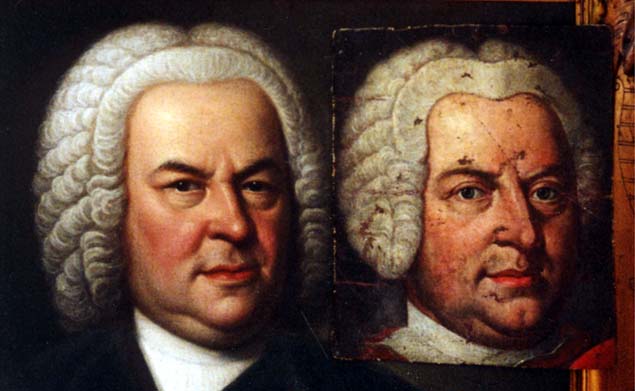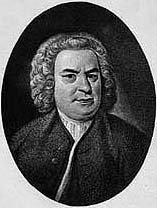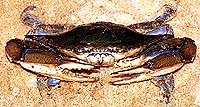Present Day Misconceptions About Bach Performance Practice in the 19th Century - The Evidence of the Recordings Pages
at the Teri Noel Towe Home Pages - Preface
Johann Sebastian Bach
Present Day Misconceptions
About Bach Performance Practice in the Nineteenth Century
The Evidence of the Recordings
This remarkable photograph is not a computer generated composite; the original of the Weydenhammer Portrait Fragment, all that
remains of the portrait of Johann Sebastian Bach that belonged to his pupil Johann Christian Kittel, is resting gently on the surface
of the original of the 1748 Elias Gottlob Haussmann Portrait of Johann Sebastian Bach.

1748 Elias Gottlob Haussmann Portrait, Courtesy of William H. Scheide, Princeton, New Jersey
Weydenhammer Portrait Fragment, ca. 1733, Artist Unknown, Courtesy of the Weydenhammer Descendants
Photograph by Teri Noel Towe
©Teri Noel Towe, 2001, All Rights Reserved
PRESENT DAY MISCONCEPTIONS
ABOUT BACH PERFORMANCE PRACTICE IN THE NINETEENTH CENTURY
THE EVIDENCE OF THE RECORDINGS
Preface
The essay, Present Day Misconceptions About Bach Performance Practice in the Nineteenth Century - The Evidence of the
Recordings, is the second of a pair of scholarly studies on specific aspects of the performance practice of Baroque music that I
prepared in the 1980s. The first of these, What Early Recordings Can Tell Us About 17th and 18th Century Vocal Technique
(for which I received invaluable and indispensable assistance from the remarkable Randolph Mickelson, one of the most
undervalued and unjustly neglected specialists in the field today) resulted from an invitation that I received, some twenty years ago,
to make a presentation at a scholarly conference at the Mannes College of Music. It was indeed an honor to share the stage with
Julianne Baird and René Jacobs, two of the finest singers that it has ever been my pleasure to hear.
The initial version of Present Day Misconceptions About Bach Performance Practice in the Nineteenth Century - The Evidence of
the Recordings was prepared at the invitation of Prof. Seymour Benstock, then a member of the faculty of Hofstra University in
Hempstead, Long Island, New York. Prof. Benstock honored me by asking me to join a phalanx of prominent Bach, Handel, and
Scarlatti specialists at a scholarly conference during the 1985 Tercentenary celebrations. One of my fellows at that remarkable
weekend was the late, great Gerhard Herz (1911-2000), who, in a lengthy conversation after my presentation, provided much
invaluable information that led to a second version of the paper, a broadcast version, which aired on WBAI-FM, in New York City,
in 1986.
The essay was revised yet again in 1988, and it is one of the essays that comprise the anthology, A Bach Tribute - Essays in Honor
of William H. Scheide, edited by Paul Brainard and Ray Robinson, that was published jointly by the Bärenreiter Verlag, Kassel, and
Hinshaw, in 1993, four years after it was presented, in typescript form, to Mr. Scheide, my treasured friend and mentor, on the
occasion of the celebration of his 75th birthday, on January 6, 1989.


I have always taken great delight in the fact that, by virtue of the papers appearing in the Festschrift alphabetically by author, my
paper comes immediately after that of Hans-Joachim Schulze and immediately before that of Christoph Wolff. One could not ask
for finer neighbors!
At the invitation of the then Rektor, Prof. Dr. Werner Felix, I presented the paper, in a German translation prepared for me by Prof.
Lothar Schmiedel of the Leipzig Universität, in the Kleines Musiksaal of the Hochschule für Musik Felix Mendelssohn-Bartholdy
in Leipzig, Germany, on September 19, 1989.
Because Festschrifts tend to have small press runs and go out of print almost immediately upon publication, Present Day
Misconceptions About Bach Performance Practice in the Nineteenth Century - The Evidence of the Recordings has had a
relatively limited circulation. Its importance to Bach scholarship at the present time seems to me to be even greater than it was when
I was first given the incentive to write it, more than 15 years ago. Sadly, we are now living in an era in which the Performance
Practice Puritans and the HIP-ocrites, as I have come to call the cultural fascists who have taken unilateral and dictatorial control of
the world of Early Music performance, have no interest in considering the possibility that the Uraufführungspraxis Valhalla that
they have constructed is built upon the shifting sands rather than upon a firm foundation.
As it is presented here, Present Day Misconceptions About Bach Performance Practice in the Nineteenth Century - The Evidence
of the Recordings is a slightly revised version of the finished text upon which the Leipzig presentation was based, and it differs in
detail from the version that is to be found in A Bach Tribute - Essays in Honor of William H. Scheide. The recorded examples, of
course, are not included in the internet version. Those who find Present Day Misconceptions About Bach Performance Practice in
the Nineteenth Century - The Evidence of the Recordings of enough significance to be interested in listening to the recorded
examples may contact me privately about obtaining, for their personal, private, non-commercial, and non-broadcast use, CD-R
copies of the "air check" of the 1986 broadcast version, in which all of the recordings discussed are presented in their entirety. The
footnotes have been relegated to a separate page, to which each has been linked. Finally, the web page construction program that I
use, alas, does not include musical notation among the available symbols, and for that reasons the note values have had to be
written out. American conventions, rather than British ones, have been followed in this context.
1. The Traditional View of Bach Performance Practice in the Nineteenth Century
2. Siegfried Ochs and Hans Weisbach
3. Joseph Joachim
4. Sir Adrian Boult and Sir Eugene Goossens
5. Why An Understanding of What Nineteenth Century Bach Performance Practice Actually Was Is A Matter of Crucial Importance
at the Beginning of the Twenty-First Century
Teri Noel Towe
June 24, 2001
P. S: That other scholarly presentation to which I alluded, What Early Recordings Can Tell Us About 17th and 18th Century
Vocal Technique, led eventually to the production of a 2 CD set for the Koch Historic series. Entitled George Frideric Handel: A
Collector's Messiah - Historic Handel Oratorio Recordings, 1899 - 1930, this album contains a significant number of the earliest
recordings of excerpts of Messiah and what I personally consider to be the single most historically important Handel vocal record
ever made, Edward Lloyd's 1908 recording of "Sound an Alarm" from Judas Maccabaeus. (Please don't tell the Performance
Practice Puritans and the HIP-ocrites about this set; the sonic evidence that it presents for all to hear might upset too many of their
sacred apple carts!) For more information on this set and to read the annotations, please click on the title of the album, George
Frideric Handel: A Collector's Messiah - Historic Handel Oratorio Recordings, 1899 - 1930. For more information on the other
transfers of historic recordings that I have produced in partnership with the unsurpassable Seth B. Winner, please visit Teri Noel
Towe - Producer of Historical Reissues on Compact Discs.
Please click on  to advance to Page 1 - The Traditional View of Bach Performance Practice in the Nineteenth
Century.
to advance to Page 1 - The Traditional View of Bach Performance Practice in the Nineteenth
Century.
Click on  to return to the Johann Sebastian Bach Index Page.
to return to the Johann Sebastian Bach Index Page.
Click on the  to return to the Teri Noel Towe Welcome Page.
to return to the Teri Noel Towe Welcome Page.
teritowe@alumni.Princeton.EDU
Copyright, Teri Noel Towe, 1985, 1986, 1989, 2001
All Rights Reserved
The Present Day Misconceptions About Bach Performance Practice in the Nineteenth Century - The Evidence of the Recordings
Pages at the Teri Noel Towe Home Pages
are PPP Free web pages.

The Present Day Misconceptions About Bach Performance Practice in the Nineteenth Century - The Evidence of the Recordings
Pages at the Teri Noel Towe Home Pages have received
the HIP Woolly Mammoth Stamp of Approval from The HIP-ocrisy Home Page.